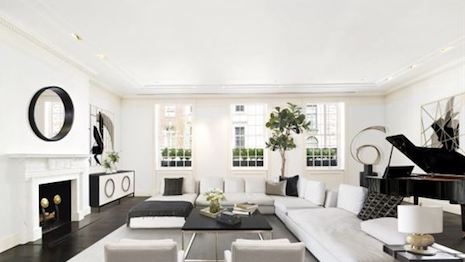- About
- Subscribe Now
- New York,
February 1, 2018

 Half of the new aristocracy deems a formal living room essential. Image credit: Luxury Portfolio
Half of the new aristocracy deems a formal living room essential. Image credit: Luxury Portfolio
Millennial and Gen X luxury homebuyers are more apt than their predecessors to have spent a lifetime surrounded by wealth, making them discerning and educated real estate consumers.
Today, the majority of consumers looking for homes priced at $1 million or more are between the ages of 25 and 49. A new report from Luxury Portfolio dubs the rising affluent class the “new aristocracy,” due to their upscale upbringing and expected financial power.
"This new generation of affluent young consumers has the potential to rival only the Rockefeller era, all driven by this new, inherited wealth," said Stephanie Anton, executive vice president at Luxury Portfolio International, Chicago.
"The difference from the generation before is that over 40 percent grew up wealthy versus today’s Boomers who generally grew up middle class or below," she said. "When you grow up with wealth you have access to education, travel, brands, trends, so this is a highly exposed, educated and sophisticated client vs the generation before who described obtaining wealth as a 'journey of discovery' and was all about constantly learning."
Luxury Portfolio’s “The Rise of the New Aristocracy” report, produced in partnership with YouGov, is based on 536 interviews with individuals 25 and older with investible assets of $1 million or more and who are in the market for a home in the next three years.
Real estate wishlist
The richest individuals are getting wealthier. A recent report from Oxfam noted that 82 percent of the new wealth created in 2017 went to the top 1 percent (see story).
More than half of the new aristocracy is expected to inherit $1 million or more, with an average inheritance of $3.8 million.
While wealth is not new, millennial and Gen Z affluents are expected to have financial power that dwarfs that of the Gilded Age.
Whereas only 30 percent of baby boomers or “luxury loyalists” grew up wealthy, 41 percent of millennial and Gen X affluents grew up surrounded by a luxury lifestyle.
As a result, these buyers know what they want.
"It is critically important, now more than ever, to be educated and informed," Ms. Anton said. "Great agents today know all the details about why something is worth it and need to be able to articulate that with confidence."
At an average age of 37, the new aristocracy is at a point in their lives where they desire urban properties with room.
More than half of the new aristocracy is looking for a home that is at least 5,000 square feet or more, and about a quarter are seeking a property that is at least 20,000 square feet. The report partly attributes this desire for space to multigenerational living arrangements and growing families.
This desire for space may also be tied to this buyer’s desire for special spaces, such as home theaters, formal living rooms and offices.
Specific spaces are important to this audience. Image credit: Luxury Portfolio
Younger buyers consider security features and entertaining space to be essential features for their next home. Commercial grade kitchen appliances, dual refrigerators and formal dining rooms are high on the list of essentials.
They also prioritize sustainability and fitness, seeking hot tubs and outdoor pools as well as proximity to gyms.
These buyers also desire smart technology for their homes, wanting auto controls for HVAC and entertainment as well as security cameras.
Luxury loyalists are at a different life stage, as they seek stability and a place to stay for a long time. Six in 10 want suburban dwellings, and 38 percent want a home between 3,000 and 5,000 square feet.
They also seek less bedrooms and bathrooms on average compared to their younger cohorts.
While this buyer does seek outdoor pools, meditation rooms and saunas, they are almost two times less likely than the new aristocracy to deem these features essential.
In the kitchen, both age groups desire commercial-grade appliances, but younger buyers put more emphasis on features such as wet bars and dual dishwashers.
Multiple dishwashers are a common desire for entertaining. Image credit: Thermador
The new aristocracy is also more likely to describe their ideal home as “private,” “relaxed” and “secure.”
Priorities
Just as there are differences between generations, consumers at varying income levels differ in their approaches to home improvement.
Affluent and mass-market homeowners often have the same values when it comes to renovating their homes, but the difference lies in how they do so.
When it comes to renovation, all homeowners are focused on communal areas such as kitchens, bathrooms and outdoor areas. Luxury homeowners, however, are more interested in transforming a room by decorating with new furniture, accessories or window treatments (see story).
In general, as consumers amass wealth, real estate will continue to rise.
The lopsided real estate market, where the availability of homes priced more than $1 million is more abundant than demand, has raised the limit of what is considered luxury to a much higher level.
Today, $5 million is considered the new $1 million within luxury real estate, as affluent homebuyers seek bigger and better to showcase lavish lifestyles. A new report from Trulia shows that the number of homes valued at the $1 million mark has quadrupled in 16 years, but $5 million homes are increasing even faster (see story).
"While it’s true that wealth at the top keeps rising, the great news is that the number of wealthy is rising, too," Ms. Anton said. "So, we have more wealthy people today than we’ve ever had before.
"Ultimately that is great news for the luxury real estate industry -- more people who understand the value of investing in real estate, more people that love it and more people that can afford it."
Share your thoughts. Click here